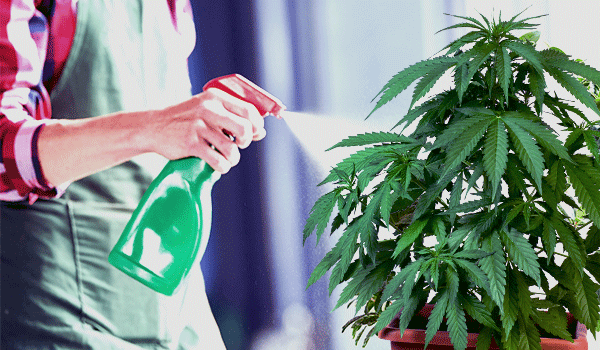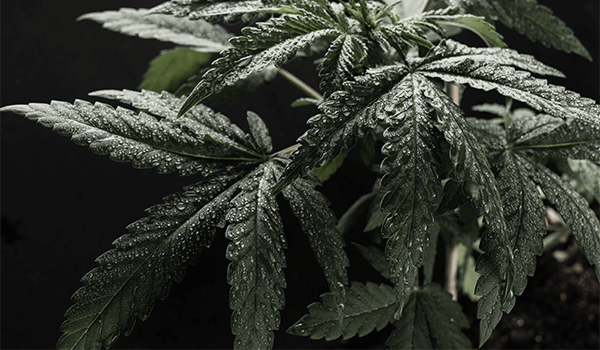How And Why To Foliar Spray Cannabis Plants
Published : Sep 24, 2019

Plants don't only feast through their roots. They can also absorb key nutrients through pores in their leaves. Foliar sprays are a great way to take advantage of this trait. However, administering them incorrectly can be disastrous. Learn how to spray like a pro below.
Did you know that cannabis plants can feed through their leaves? That's right; it's not only their roots that can uptake nutrients. Growers can dilute nutrients into a spray and apply them directly to plants—a practice known in the cultivator lexicon as "foliar spraying" or "foliar feeding".
Fan leaves can rapidly absorb nutrients through tiny pores on their surface known as stomata. This speedy route of delivery allows growers to quickly remedy nutrient deficiencies. But it's not only useful for ailing plants. Foliar spraying can also be used to optimise the health of already thriving specimens. Moreover, foliar spraying can be used to apply organic pesticides and insecticides to rid your plants of infestations.
Before you go out and douse your entire crop with liquid feed, let us kindly stop you. There are nuances to these techniques. As much as it can rescue dying plants, it can also kill healthy ones if carried out incorrectly.
Let's explore how foliar spraying works, the advantages and disadvantages, and how to administer it properly.
HOW DOES FOLIAR SPRAYING WORK?
Cannabis plants need around seventeen different nutrients to meet all of their physiological needs. These include the macronutrients nitrogen, phosphorus, and potassium—which plants require in large quantities—and micronutrients such as iron and copper, which they need in smaller amounts.
Plants uptake most nutrients through their extensive root system. Flow created through leaf transpiration (when plants release water vapor) creates suction at the roots. This causes them to uptake water and nutrients, which are then distributed to the leaves and stem via the vascular system.
However, plants also uptake nutrients through the air. During photosynthesis, the stomata open and "breathe in" carbon dioxide. It's through the stomata that plants can also uptake nutrients from foliar sprays. It's essentially an alternative way into the vascular system.
But stomata aren't the only access point for nutrients through leaves. Both organic and inorganic materials can pass through the surface of cannabis leaves via the cuticle—a waxy layer that prevents water loss. Once the cuticle has been penetrated, nutrients go on to pass through the cell wall, and finally the cell membrane.
As you can imagine, the journey through the cuticle and other barriers is much longer. Nutrients that access the stomata directly enter the vascular system. This makes these pores the preferred target of foliar feeds.

THE ADVANTAGES OF FOLIAR SPRAYING
Now that we know how nutrients enter leaves, let's take a look at why growers choose to foliar feed.
Foliar feeds cannot meet the complete nutritional needs of a cannabis plant. Look at them more as a supplement. When something is missing in the soil, or a plant is struggling to uptake it, a foliar spray can be used as a temporary solution.
When a plant doesn't have access to a particular nutrient, symptoms of deficiency can arise. These can range from discolouration and wilting to the full-blown death of a plant. Foliar feeding allows growers to directly target specific plants and leaves that display these symptoms. This enables a degree of accuracy much higher than adding extra nutrients to the soil.
It may just be a single plant that is struggling with deficiency. As opposed to treating the entire growing medium, foliar spraying is a highly localised means of correcting an issue.
As mentioned above, foliar sprays can also be a great way to apply natural pesticides like neem oil, without any undue damage to plants. This method is particularly useful for pests like powdery mildew, because it allows you to combat the pathogen directly, rather than via the root system. In addition to neem, everything from cayenne pepper to tea tree oil has applications as a foliar spray. But beware; these substances need to be significantly diluted and mixed with a small amount of insecticidal soap to be most effective.
THE DISADVANTAGES OF FOLIAR SPRAYING
The main disadvantage of foliar spraying is that it's a temporary fix. It can resolve nutrient deficiencies in the short-term, but it doesn't directly address the core problem.
If a nutrient is missing from the soil, foliar feeding can replace it. But if deficiency is arising due to pH balance or root disease, this method will only go so far.
HOW TO FOLIAR SPRAY: A BEGINNER'S GUIDE
Foliar feeding plants is a relatively simple process. But you need to be aware of what not to do. A slip-up here could cost you an entire plant. Follow these tips to ensure a fail-safe application.
SPRAY DURING THE CORRECT GROWING PHASE
The growing cycle is composed of several stages: germination, seedling, vegetative, and flowering. You should only administer foliar feeds during the vegetative phase and the early flowering phase.
The vegetative phase refers to the period of robust growth in which plants develop their branches, stems, and fan leaves—but no flowers. During the early flowering stage, small buds known as “pre-flowers” begin to form at the nodes.
It's important not to spray during peak flowering. This can lead to nutrient residue building up on the flowers, which makes for a harsh, unpleasant smoke that is enough to ruin your entire bounty. Same goes for foliar spraying organic pesticides; you want to avoid any direct contact with the flowers, instead focusing on the leaves and other surfaces that won’t be smoked. However, if some of your fan leaves have been attacked by pests during the flowering stage, it is possible to safely apply foliar spray to just the leaves themselves, avoiding contact with the flowers. Caution is advised.

FEED PLANTS AT THE RIGHT TIME OF DAY
To maximise absorption, apply foliar feeds when the stomata are open. Remember, these pores draw in carbon dioxide during photosynthesis. This means they are open during the day, or whenever the grow lights are switched on.
However, spraying your plants when they are exposed to the heat of grow lights or the sun can inflict damage upon the leaves. Lingering water droplets can magnify the light source and cause leaf burn.
For this reason, precise timing is required. The stomata remain open for approximately 20 minutes after the sun has set or the grow lights have been switched off. This is the ideal time to spray them. You won't risk burning them, and the nutrients will still be effectively absorbed.
DIAL IN YOUR SOLUTION TO AVOID DEVASTATING RESULTS
When making your foliar spray solution, be sure to follow the product instructions carefully. If you go overboard and add too many nutrients (or too many organic pesticides), you run the risk of damaging the leaves and potentially killing the plant.
For young plants, it's advised to use 20% of the recommended nutrient product strength. If you're administering to larger vegetative plants for the first time, use a 50% nutrient strength to determine the effects.
If you're unsure, it's always a good idea to test your spray on a single leaf first to see how it reacts.
DON'T SPRAY YOUR OUTDOOR PLANTS IN BAD WEATHER
Avoid foliar feeding your outdoor crop before rain is forecast. The nutrients are water-soluble and could be swept off the surface of leaves before they have the chance to be captured by the stomata.
High winds can also blow foliar feed off a plant. Save your solution for when the weather is compatible.
DEVELOP AN EFFICIENT TECHNIQUE
When spraying a nutrient-deficient plant, it's important to hit all of the symptomatic leaves. Work in a pattern that minimises the chances of missing any surfaces. Start from the top and work down in a spiral pattern to ensure proper, comprehensive administration.







































